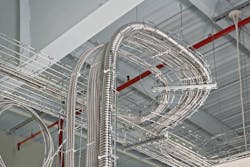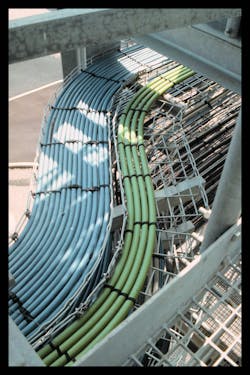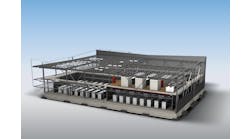Future-Proofing Data Centers: The Crucial Role of Bonding and Grounding Wire Mesh Cable Trays
With the global data center infrastructure market projected to skyrocket from USD 50 billion in 2021 to an astounding USD 120 billion by 2030, at an impressive Compound Annual Growth Rate (CAGR) of 12%, there's no time to waste in seizing the opportunities ahead.
In order to ensure long-term success and ride the wave of this booming industry, businesses of all sizes must prioritize the installation of bonding and grounding wire mesh cable trays in their data centers. This strategic decision establishes a solid foundation that enables scalability and adaptability in the ever-evolving technology landscape, while also maintaining a secure and reliable infrastructure.
To achieve unparalleled success in the data center industry, professionals must recognize the critical significance of bonding and grounding wire mesh cable trays and delve into the essential advantages they offer. These benefits include labor savings, enhanced safety for both personnel and equipment and the overall importance of their implementation. By comprehending these factors, data center professionals can unlock the potential for significant growth and excellence in their operations.
In addition, businesses that adhere to UL Classification standards ensure optimal performance and protection in the data center environment. By comprehending and giving proper precedence to these critical considerations, businesses can achieve heightened efficiency and safety within their data centers. This adherence to UL Classification standards plays a vital role in ensuring the smooth and secure operation of data center facilities.
To capitalize on the rapid growth of the data center market, businesses must be ready to leverage the potential of bonding and grounding wire mesh cable trays. With data centers expected to continue expanding at an extraordinary pace, it is imperative to position your data center for unmatched growth and success. Embrace the future of technology with confidence and stay ahead of the curve in this rapidly evolving industry.
Bounding and Grounding Benefits for Data Centers
Embracing bonding and grounding measures in data centers doesn't just stop at infrastructure; it opens the door to a plethora of benefits that drive overall operational excellence and ensure the safety of employees.
Future-Proofing
By implementing these measures, companies can future-proof their data centers, effortlessly staying one step ahead of technological advancements, industry trends, and the ever-evolving needs of their business. It's all about preparing for the future, especially considering the impending shortage of electrical engineers in the labor market. With the right measures in place, businesses can secure continuous growth and unwavering stability in their operations, no matter what lies ahead.
Safety
When it comes to personnel safety, incorporating bonding and grounding solutions takes center stage, playing a vital role in safeguarding employees. These measures act as a shield against electrical faults, channeling any potential hazards directly into the grounding system. This proactive approach effectively reduces the risk of electric shocks and minimizes the potential for irreparable harm to personnel. Moreover, grounding provides a low-impedance path to trip breakers, meeting a critical safety requirement. This means that in the event of a fault, the electrical system is swiftly disconnected from the power source, preventing further harm or damage to both individuals and equipment.
Reducing EMC Issues & Noise
Bonding and grounding also have a significant impact on reducing EMC issues and combating noise-related challenges. By eliminating electro-static potential, these measures protect hardware servers, storage devices, networking equipment, and other crucial components from irreversible damage. Additionally, by eradicating induced magnetic currents, they prevent noise and signal distortion, leading to enhanced data transmission accuracy, improved network performance, and optimal equipment operation.
Bonding Versus Grounding
In data centers, bonding is the main focus as it involves connecting all components together to create a cohesive electrical conductive system. Proper bonding helps ensure that the system is electrically continuous and can safely complete a circuit and trip a breaker/fuse To ensure proper bonding, UL Classified Splices are used, allowing for spliced sections of field-modified Wire Mesh Cable Trays. These splices ensure that the cable tray system operates correctly, promoting safe, efficient cable routing and management within the data center.
In data centers, grounding ensures the cable tray system is connected properly to the earth to ensure that equipment or the tray itself can safely conduct current posed upon them. This “drain to earth” acts to prevent noise and unwanted currents that can affect the performance of the network. Quite often, a green (or bare) conductor serves as the Equipment Grounding Conductor (EGC.) A cable tray is allowed per NEC 392 to act as the sole EGC, hence a green wire. This eliminates the need for a separate grounding wire. Many cable tray installations do not use the tray as the sole EGC. However, it is very important to utilize UL-classified splices for every tray connection, no matter if the tray is the EGC or not. Self splicing cable trays do not meet the minimum standard of resistance per NEMA VE1, NEC, and UL and require an additional bolted connection to be added to make the system Bonded and grounded per NEC and UL. Proper grounding and bonding practices ensure electrical safety and compliance in data centers.
Compliance is Key
As the world of data centers continues to expand, it becomes increasingly crucial to prioritize innovation and ensure the safety of both employees and equipment. Maintaining compliance with UL standards is paramount in this regard. Legrand/Cablofil offers a comprehensive range of wire cable trays and splices that are rigorously tested and comply with CSA, IEC, NEC, NEMA, and UL requirements for low resistance.
Achieving excellent electrical continuity and grounding is essential for creating safe installations and reducing the risk of electrical shocks. Data centers can ensure a secure and reliable electrical infrastructure by utilizing Legrand/Cablofil wire cable trays and their wide range of UL Classified splices.
Bob Crain is Director of Marketing/Product Development for Legrand and Cablofil. For a complete list of UL Classified splices designed specifically for bonding and grounding wire mesh cable trays, visit Legrand's website. This resource provides valuable information and guidance to ensure the implementation of high-quality and compliant solutions in data center environments.








